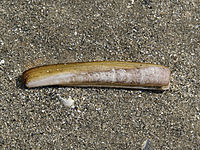
Photo from wikipedia
Squirt driven by local pressure imbalance between contact of grains (or throat) and the main pore space is a mechanism of P-wave attenuation in consolidated rocks. In this paper, we… Click to show full abstract
Squirt driven by local pressure imbalance between contact of grains (or throat) and the main pore space is a mechanism of P-wave attenuation in consolidated rocks. In this paper, we investigate squirt in unconsolidated and consolidated porous media (represented by Toyoura sands and compressed glass beads, respectively). The former sample has very small bulk modulus and shear modulus, manifested by relatively free/mobile grains. As such, solid stress on the surface tends to be uniform and squirt should be minor. Biot’s theory improved with dynamic permeability successfully predicts the ultrasonic velocity and quality factor of P wave measured in the unconsolidated sands, confirming the aforementioned judgment. Dynamic permeability inverted at a high frequency is far lower than Darcy permeability. However, the improved model remains to be incapable of predicting velocity and attenuation measured in the latter sample; the reason is that the compressed beads allows a high pressure at compliant throat which drives strong squirt between throat and the main pore space.
Journal Title: Geofluids
Year Published: 2020
Link to full text (if available)
Share on Social Media: Sign Up to like & get
recommendations!